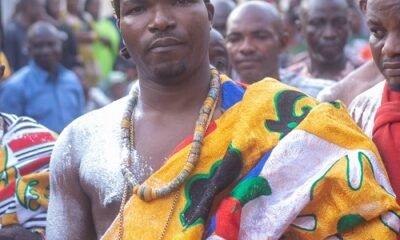Fruitful Living
MTN Stands in Worship 2025: A divine stage where praise meets purpose
Year after year, one event on Ghana’s entertainment calendar draws thousands with a magnetism that’s hard to explain but impossible to ignore—MTN Stands in Worship.
Now firmly entrenched as the country’s most beloved gospel concert, the 2025 edition held at the Grand Arena Dome on April 20 proved once again why it’s more than just a musical gathering—it’s a national spiritual revival, a cultural celebration, and a purposeful platform for both emerging and veteran gospel voices.
For many Ghanaians, Stands in Worship is not just an event; it’s a sacred appointment. An annual Easter tradition that brings together people of all walks of life, it embodies the power of music to inspire, heal, and unify.
Honouring veterans
One of the defining pillars of MTN Stands in Worship is its unwavering commitment to supporting gospel musicians, particularly those whose voices once ruled the airwaves but are now less seen in mainstream circles.
This year’s performance by the legendary Tagoe Sisters was a testament to MTN’s conscious effort to preserve and promote the heritage of gospel music.
In an era where platforms are often skewed toward the young and viral, MTN has carved out space for Ghana’s gospel pioneers to shine again. Their return to a grand stage was more than nostalgic—it was a powerful statement: your ministry still matters.
Talents
MTN’s investment in the gospel space goes beyond lights and sound. With initiatives like the MTN Viva Voices, which opened this year’s show with roof-raising praise, the company is actively developing young gospel talent.
The group, made up of professionals with a heart for ministry, brought a sound so powerful it instantly raised the spiritual temperature in the Dome.
And then came the spiritual architects—Moses OK, Nacee, Bethel Revival Choir, and Empress Gifty—each delivering powerhouse performances that moved both body and soul. These acts aren’t just popular, they’re transformational, and MTN has been instrumental in giving them a platform to minister on a massive scale.
Anticipation
It’s no exaggeration to say Ghanaians wait all year for this night. Long before tickets go on sale, social media buzzes with anticipation. The phrase “Are we standing this year?” has become a coded expression of hope, joy, and spiritual yearning. For many, the concert was more than a show—it’s a turning point.
Take Maame Serwaa from Amasaman, for example. Like thousands of others, she made the journey, braved the queues, and danced with a heart full of praise. “This is where I reconnect with God in the loudest, most beautiful way,” she said. “I wish it happened every month.”
Not just performance
MTN’s approach to Stands in Worship is refreshingly different from the typical corporate-sponsored concert. While entertainment is high on the agenda, the brand’s true intention is impact. Through uplifting messages, acts of kindness (including giveaways of airtime and smartphones), and powerful moments of worship, MTN leaves its audience not just entertained—but transformed.
And the ripples extend far beyond the Dome. Gospel artistes gain visibility, streaming numbers soar, and many find renewed relevance and ministry opportunities after performing on the Stands in Worship stage.
Looking ahead
As the final chords of Empress Gifty’s thunderous finale echoed through the Grand Arena Dome and the crowd slowly spilled into the night, one thing was clear: MTN has once again created something rare—a national altar in the form of a concert.
A night where technology meets testimony, branding meets blessing, and Ghana’s gospel heartbeat is heard loud and clear.
With its perfect blend of worship, celebration, and purpose, MTN Stands in Worship has not only lifted hands—it has lifted lives, elevated the gospel industry, and preserved a sacred space in Ghana’s music culture. And in doing so, it has become not just a concert— but a legacy.
Review by Andrew Nortey
Fruitful Living
Has man lost the essence of his creation? A reflective call to rediscover our divine purpose (Part 1)
Introduction: Rediscoveringour purpose
Praise be to Allah, the Lord of the Worlds. We praise Him, seek His help and forgiveness, and ask for His mercy. May the peace and blessings of Allah be upon our noble Prophet Muhammad (peace be upon him), his family, his companions, and all those who follow his guidance until the Day of Judgment.
In today’s increasingly materialistic and turbulent world, a profound question echoes louder than ever: Has man lost the essence of his creation? It is a question that compels every thinking soul to pause and reflect deeply.
In the midst of scientific breakthroughs, booming technology, and economic pursuits, we must ask ourselves: are we fulfilling the sacred purpose for which we were created? Are we still living as stewards of Allah on earth, or have we strayed from our divine assignment?
This article explores the Qur’anic foundation of man’s creation, the noble position he holds, and the deviation from this divine path in modern times. It further calls for a return to spiritual consciousness and outlines practical steps to help realign mankind with his intended purpose.
Man: Allah’s Vicegerent on Earth
The Qur’an states: “And when your Lord said to the angels, ‘Indeed, I will make upon the earth a vicegerent (Khalifah)…’” (Surah Al-Baqarah, 2:30).
This declaration marks the beginning of man’s honorable journey on earth. Mankind was created from clay, as recorded in Surah Al-Hijr:
“And We did certainly create man out of clay from an altered black mud. And the jinn We created before from scorching fire. And [mention] when your Lord said to the angels, ‘I will create a human being out of clay from an altered black mud.’ So when I have proportioned him and breathed into him of My [created] soul, then fall down to him in prostration.” (Surah Al-Hijr, 15:26-29).
This prostration of angels was not to worship Adam, but to recognize the honor Allah had bestowed upon man. It signified a spiritual hierarchy in which man, though of earthly origin, carries a divine trust and responsibility.
Prophet Muhammad (peace be upon him) emphasized this dignity. He taught that every human is born upon the natural disposition (fitrah) and bears the potential to fulfill their purpose as a servant of Allah and custodian of His creation.
The Purpose of Creation
Allah did not create man in vain. The Qur’an states clearly: “And I did not create the jinn and mankind except to worship Me.” (Surah Adh-Dhariyat, 51:56).
“And they were not commanded except to worship Allah, [being] sincere to Him in religion, inclining to truth, and to establish prayer and to give zakah. And that is the correct religion.” (Surah Al-Bayyinah, 98:5).
Another profound verse underscores that life was not created aimlessly:
“And We did not create the heaven and the earth and that between them aimlessly. That is the assumption of those who disbelieve, so woe to those who disbelieve from the Fire.”(Surah Sad, 38:27).
These verses convey that creation is intentional, meaningful, and divinely ordained. The essence of man’s creation lies in his recognition of Allah, his conscious submission to the Divine Will, and his dedication to a life of worship, service, and ethical living.
Worship in Islam is not confined to rituals alone but extends to every aspect of human existence—how we earn, govern, lead our families, engage with society, and preserve the environment. Every righteous deed done with sincerity for Allah’s pleasure becomes an act of worship.
Imam Al-Ghazali explains in Ihya Ulum al-Din that true worship stems from knowledge of Allah and a heart that submits lovingly to His will. Ibn Qayyim al-Jawziyyah likewise stresses that man’s highest honor lies in fulfilling the purpose of servitude (`ubudiyyah) to Allah, which brings inner peace and divine elevation.
Prophet Muhammad (peace be upon him) demonstrated this perfect balance of worship and engagement in worldly affairs. He was a husband, a leader, a statesman, and a worshipper who said: “The most beloved deeds to Allah are the most consistent, even if they are few.”
(Sahih al-Bukhari, Hadith 6464)
Living in harmony with this divine purpose not only brings personal fulfillment but also collective peace. Conversely, neglecting it results in moral confusion, injustice, and spiritual emptiness.
Therefore, recognizing and living by our purpose is not a luxury but a necessity. It is the key to real success in this life and salvation in the Hereafter.
By Imam Alhaji Saeed Abdulai, the Author
Fruitful Living
Trusting God with our anxieties (final)

Jesus not only instructs us not to worry — He explains why worrying is counterproductive to our well-being:
❖ Worry is blind. It refuses to learn from nature, history, or personal experience. Birds and flowers testify to God’s faithfulness. The history of Israel is filled with God’s miraculous provision — from Egypt to the Red Sea to the Promised Land (Deut. 8:14–15).
❖ Worry refuses to learn the lesson of life. Time and again, God has helped us bear the unbearable and overcome the insurmountable. He strengthens us even when we reach the breaking point — and keeps us from breaking.
❖ Worry is irreligious. It stems not from our external circumstances, but from a heart full of fear and distrust. Yet Scripture declares:“You will keep in perfect peace him whose mind is steadfast, because he trusts in you.” — Isaiah 26:3 (NIV)
The antidote to worry: El shaddai
Proverbs 18:10 says, “The name of the Lord is a strong tower; the righteous run to it and are safe.” One of the most comforting names of God is El Shaddai, which first appears in Genesis 17:1 and appears 218 times in the Bible.
❖ El means “Strong One.”
❖ Shaddai means “The Breasted One.”
Together, El Shaddai paints a picture of God as:
❖ Our Strong Nourisher
❖ Strength Giver
❖ Satisfier
❖ All-Bountiful Supplier
❖ Fulfiller of Needs
❖ The Life-Giver who brings dead things back to life
(e.g., Abraham and Sarah conceiving Isaac at 150 and 90 years respectively)
In knowing who God is, we find the courage to release our anxieties. If He is truly El Shaddai — strong, sufficient, and sustaining — then we are safe in His hands.
Practical steps to peace
In Philippians 4:6–7, we are given a divine prescription for peace:
1. Stop being anxious and fretful. Recognize the emotional and spiritual toll of worry.
2. Go to God in prayer about everything. Nothing is too big or small.
3. Pray for yourself. God is your Father — your relationship with Him is personal.
4. Thank Him as you pray. Gratitude builds faith and reminds us of His past faithfulness.
When we do this, God’s peace — not the world’s peace — will guard our hearts and minds in Christ Jesus.
“And the peace of God, which transcends all understanding, will guard your hearts and your minds in Christ Jesus.” — Philippians 4:7 (NIV)
CONCLUSION
We are living in uncertain times. Pressures abound and anxieties easily multiply. But as children of God, we are called to walk a different path — one of quiet confidence, steady trust, and daily surrender.
God’s Word is clear: worry doesn’t help — but trust in God brings peace. Let us shift our focus from fear to faith, from anxiety to adoration. Let us anchor our hearts in the unchanging character of El Shaddai — our Almighty God — and rest in His perfect care.
By Rev. Dr Joyce Aryee, the author






